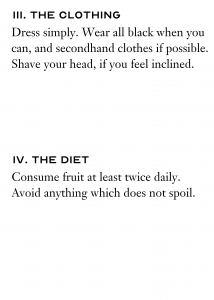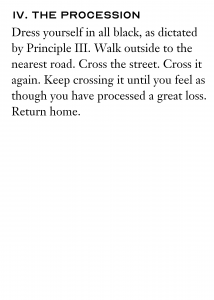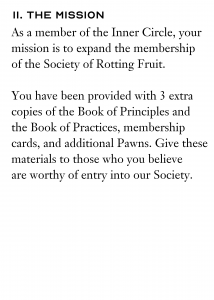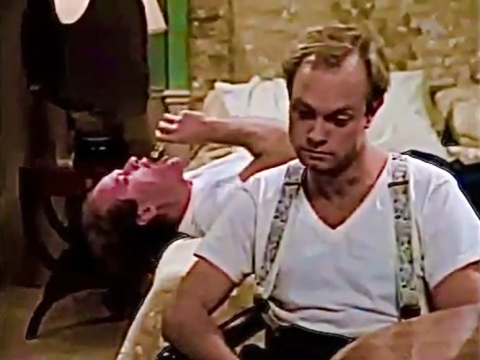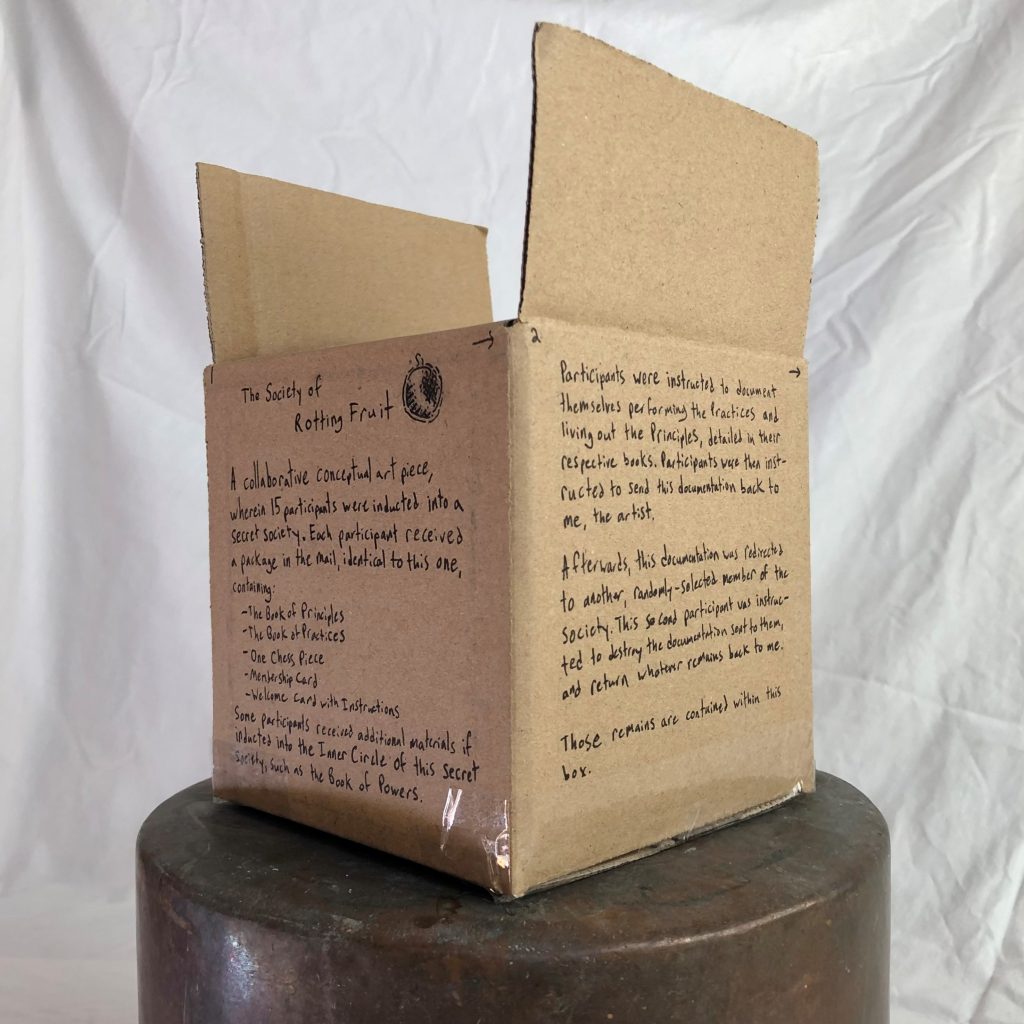
My conference project this semester really began with a simple desire: to make a secret society as a conceptual art piece. I’ve always been fascinated with secret societies. Something about the ritual of it all—the handshakes, the codewords, the dress—has just really consistently appealed to me throughout the years. I specifically became fascinated with this performance aspect surrounding secret societies, and the way in which membership in a secret society acts almost as a constant kind of performance piece. It is as though members upon entering a society would receive a set of instructions (like an event score) and follow those instructions for an indefinite period of time. And this mechanism of an instruction to perform an act in perpetuity—that is what really piqued my interest.
In its earliest form, this project was going to operate less with secret societies and more with religions, as the mechanism I wanted to play around with seemed to lend itself to questions of religious organizations. Namely, I wanted to enact the performance of religious practice without necessarily being critical of religious practice; I wanted to facilitate experiences that felt meaningful, despite everyone involved being aware of the fact that they were meaningless, that I had made them up. I also wanted to investigate this element of implied trust present in a lot of religious traditions, in that religious bodies lack a means of enforcement—nobody is going to check to make sure you’re praying regularly. And so I wanted to essentially provide participants with a set of performances, via a set of sacred texts, instructing them simply to do the performances; I would just have to trust that they were being performed.
This concept ended up being kind of weak. It made for a funny premise—do this performance art piece until you die—but it lacked depth. It wasn’t conference-worthy. And on top of that, the tone I intended didn’t really come through. As a religious person, I went into this project with an awareness that a lot of art students have really bad takes about religion, and I specifically wanted to avoid making such takes in my art; and yet the piece still came across that way, feeling mean-spirited and ironic when I actually meant it to be pretty sincere.
So I started over, going back to the idea of a secret society, and I worked more within that syntax. I gave this society more of a structure, and worked through the logistics of how this society would operate. With this came the arrival of a third sacred text, one that would be limited to members of the so-called Inner Circle. I also decided pretty early on that I wanted to avoid using technology as much as possible, as zoom burnout made the idea of hosting, say, an electronic event for my society just completely unbearable. These two decisions helped steer the ship of this project away from “instructions and perpetuity” and toward “secrets and decay,” with this question of secrecy over time becoming the focal point of this project.

What I ended up with was the Society of Rotting Fruit. It was (or maybe is?) a secret society centered around this idea of decomposition, operating under the premise that, for a secret to truly be kept, it must be kept until death. It was a society that celebrated decay, as decay meant the successful burying of secrets. Members were inducted into this society via a Google Form shared on social media, asking hopeful inductees for their name, mailing address, email address, and for them to choose a chess piece. The mailing address was so that I could mail each participant a kit, containing:
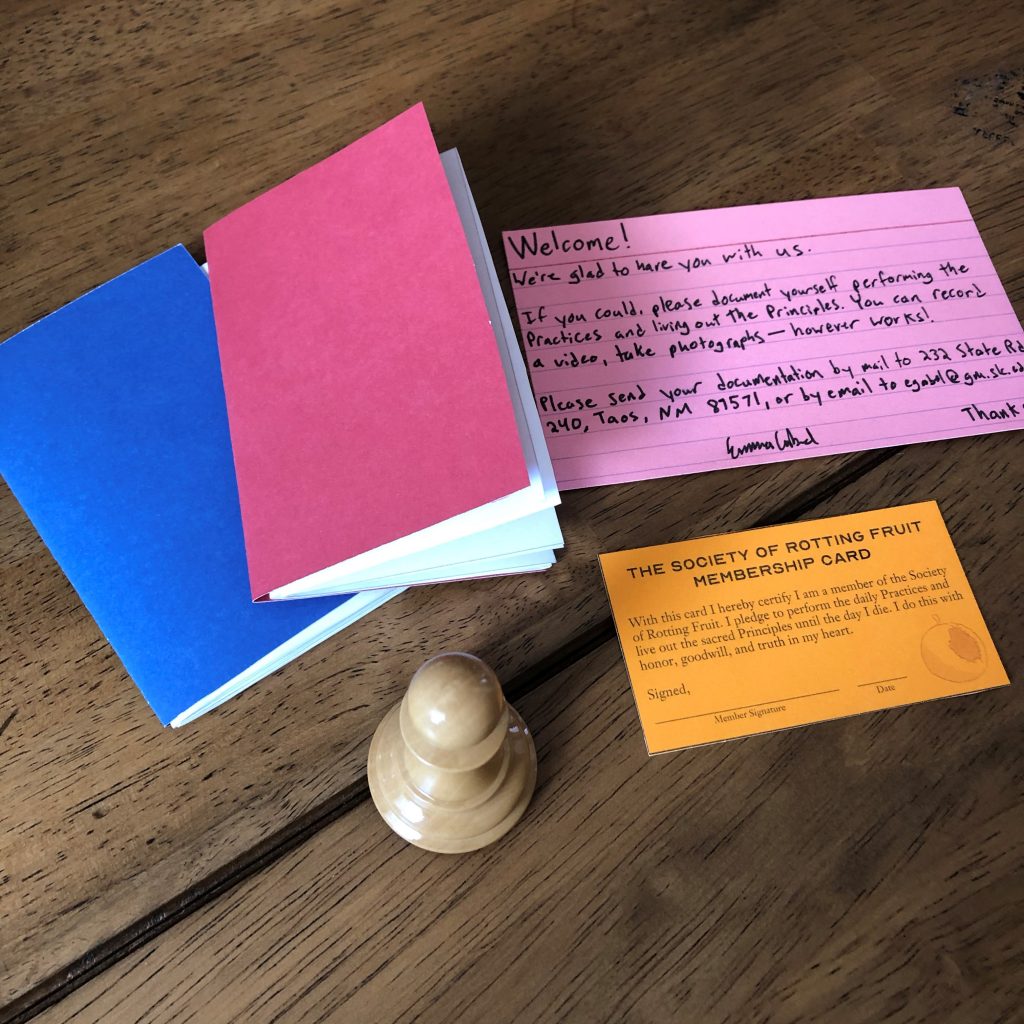
The email address was so that I could communicate with participants if something went awry in the mail, and so that, when the piece eventually came to an end, I could let everyone know without mailing out a dozen letters. The chess piece was how I decided to create the power structure of this society: if an inductee selected the Bishop, they would be made a member of the Inner Circle. Members of the Inner Circle would receive everything contained in the standard kit, as well as 3 extra copies of the sacred texts, 3 extra chess pieces, and 3 extra membership cards, so that they could induct new members into the society. Inner Circle members would also receive The Book of Powers, detailing their privileges as a member of this most sacred order, and instructing them to decide, via monthly election, when to end the piece.

Everything included in the kits was meant to be destructible in some way, so that members could eventually destroy their kits when instructed. Over the course of the project, this vague idea that everything would be destroyed became clarified thanks to this issue of incentive. That is, with my original idea, it wasn’t enough to just trust everybody to do the performance as instructed; I had to make people want to perform. So in the Welcome Letter, I promised participants a special reward for those who not only performed the rituals, but documented their performance, and sent that documentation back to me.
This reward ended up being the reward of destruction. Members who submitted documentation would be given the documentation of another member, and instructed to destroy it in some way. They would then be instructed to return the remains to me. And I thought, this is great! This is entirely self-consistent with the society’s core values! Every performance is done in secret, and so it makes sense for the records of those performances to be kept secret too, yet still be shared in a limited fashion—the documentation would not be secret, but would rather be a secret. “Ha ha,” I said. “I’ve done it!” And so members would destroy the documentation, and carry on performing the rituals until the Inner Circle decided to end the piece.
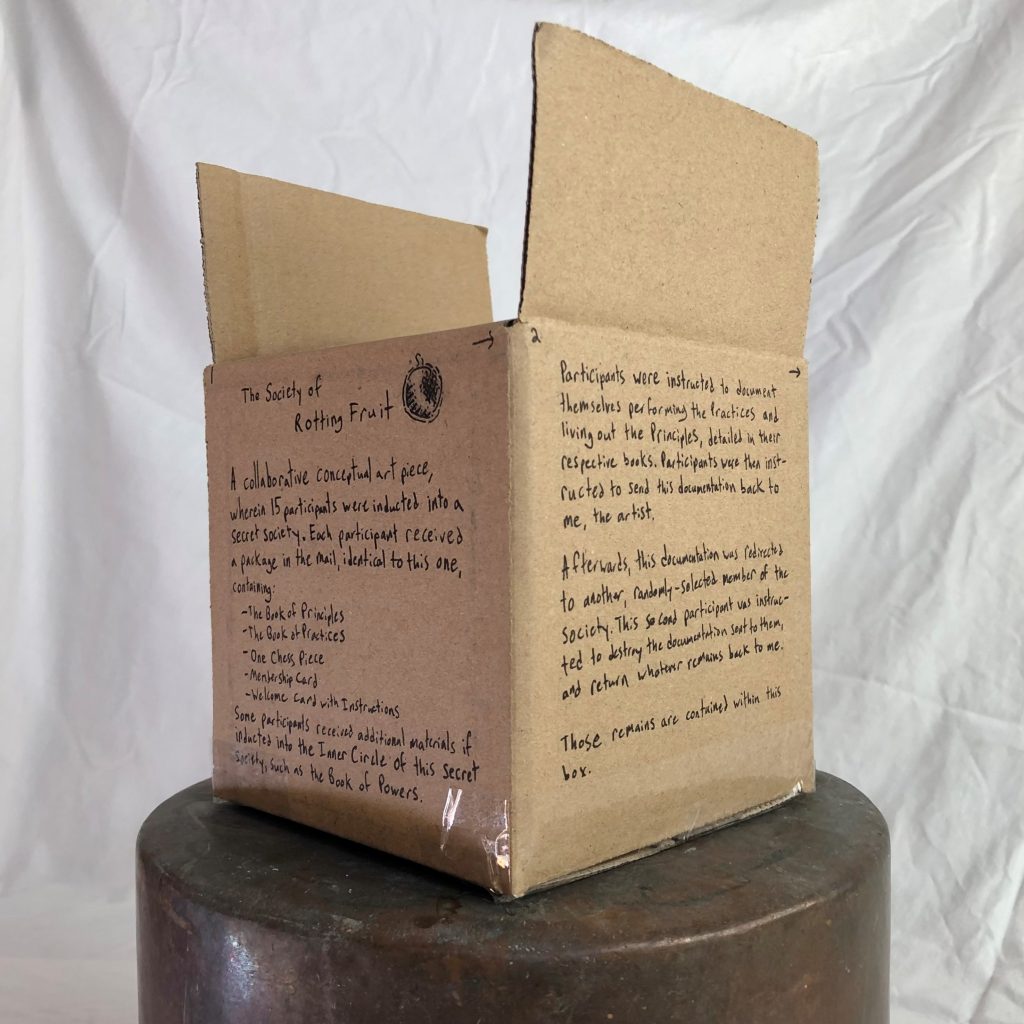

I failed to consider, of course, what to actually do with those remains once I got them. I toyed around with a few ideas, but what I eventually ended up with was this idea of putting the remains in a vessel, and having this vessel as the art-object manifestation of a largely dematerialized art. It would be something I could point to, standing on a plinth in a gallery, and say, “Look—this is my secret society.” For a while, I thought about buying an urn to play with the themes of death and decay, but that felt inconsistent with the values behind my society, as urns do not readily decompose. I ended up going with one of the spare 5 inch by 5 inch by 5 inch boxes I had used to ship the kits out, with a description of the project written across the sides. This cardboard box would sag and lump over time, and could be destroyed when I was fully done with the project, leaving behind no trace of the Society of Rotting Fruit. In the Book of Powers, there’s a section detailing something called the Day of Rot, this doomsday element to the society that is predicted to occur on a specific date. I decided to destroy this final box a hundred years prior to the Day of Rot, finalizing this last element of destruction to the piece, and concluding my work on the project.
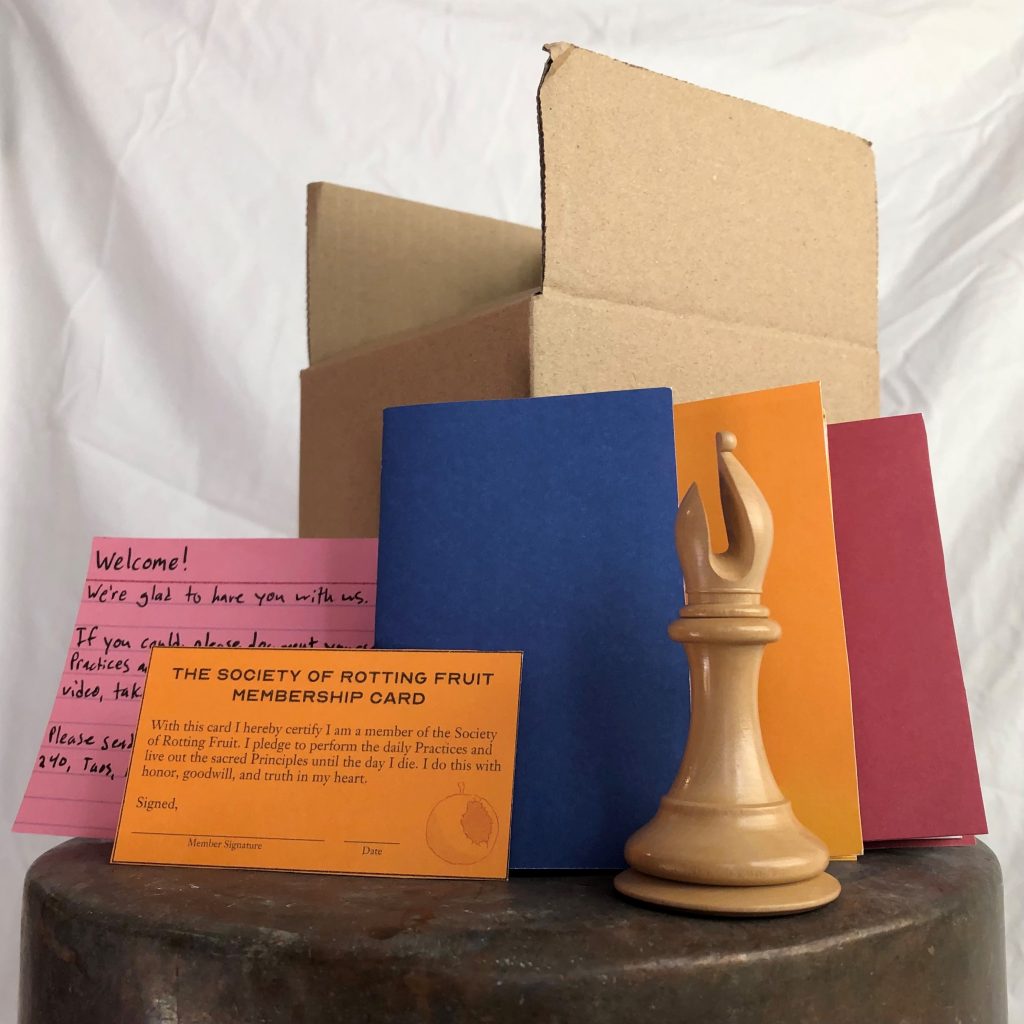
I think what’s really interesting about this piece is how drastically it changed over time, and how beneficial the process of refinement was to the project. When it came to conceptual art, I had always operated in a very immediate kind of way—I would have an idea and I would make it, and I wouldn’t think too much about the details. And while I do think this process is good in some ways, I do think for this project the added thinking was crucial, as the original concept was really half-baked. I’m much happier with this project now that I’ve refined it so thoroughly and made it so internally self-consistent. While I’m not sure I’ve made terribly great art, I do think I’ve made something really fun with this project, and I’m excited to see peoples’ documentation as it starts rolling in over the following weeks. I got to play around with a lot of forms that had interested me, but that I had not been able to explore until now, and that experience was super beneficial to me. It’s like, I’ve always liked the idea of dematerialized art, and of mass performance art, and of art that uses the postal service—and now I’ve made just that! Really, this whole project was a massive learning experience, one that has really improved how I go about making art, and that will hopefully enrich the work I make in the future.

